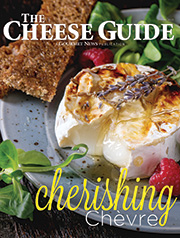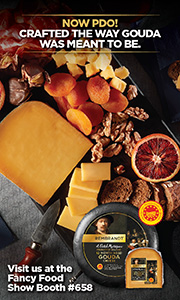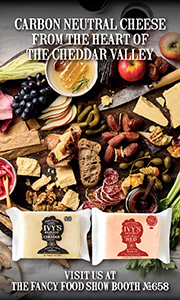
Confections
Sweets & Snacks Expo Bolsters Educational Offerings With Snack Experts
Executives from IRI, Geometry Global and Integer will deliver presentations on the current state of snacking and what trends are shaping the future at the 2016 Sweets & Snacks Expo, hosted by the National Confectioners Association. The snack-focused sessions will take place at the trade show’s new Discovery Theater located in Skyline Hall. The Sweets & Snacks Expo will take place May 24-26 at McCormick Place in Chicago, Illinois.
“In addition to the business done on the show floor, we want to provide Expo attendees with the latest insights they can use to make informed business decisions,” said Barry Rosenbaum, Expo Chairman and President of Nassau Candy Distributors, Inc. “With snacking clearly on the rise, we feel strongly that these category thought leaders will provide attendees with a unique learning experience.”
IRI’s Sally Lyons Wyatt, Executive Vice President & Practice Leader, client insights will present on the state of the snack industry, providing the latest research on segment growth and opportunity development. Lyons Wyatt is an authority on consumer eating and shopping trends with more than 25 years of industry experience.
Geometry Global’s Director of Multicultural, John V. Burn, will examine how shifting demographics will impact shopping behavior over the next five years and specifically its impact on the snack category. Burn’s experience on multi-cultural snacking includes serving as managing director Brazil for SAB Miller in Latin America and general manager for Travel Retail of Diageo.
The Integer Group’s Craig Elston, Executive Vice President, Insight & Strategy will provide attendees with insights on how the growth of online purchasing can be an opportunity for the candy and snack industry. Elston, having spent a vast majority of his career in integrated strategy roles, will share the latest online shopper research and how brands and retailers can capitalize on burgeoning trends.
NCA’s 2016 Sweets & Snacks Expo will set an all-time record in volume of confectionery and snack products with more than 720 companies showcasing nearly four acres of product innovation. The show floor expanded into a second hall, the new Skyline Hall, to accommodate the growing exhibitor base and plans to welcome more than 16,000 industry professionals from nearly 90 countries.
Category experts from Bell Flavors & Fragrances, Inc., Canadean, Center for Advancing Retail & Technology, LLC, Consumer Technology Association, Natural Marketing Institute and Progressive Grocer are also set to speak at the new Discovery Theater.
For more information, visit sweetsandsnacks.com.
Italian Delicacies from Cibo California
by Lorrie Baumann
Start-up company Cibo California, founded last year, has reached exclusive distribution agreements for artisanal products previously unknown in the United States and is ready to launch them into the American market. Cibo California CEO Massimo Cannas says he spent months and even years persuading families that make artisanal Italian food products in traditional ways to share these products with the American market and to trust his company with that mission.
One of those product lines is Campofilone egg pasta from the Pastificio Decarlonis Srl, a family company run by brothers Paolo, Pietro and their father Enzo Decarlonis, who agreed to hold a “serious family meeting” after a long conversation with Cannas that ended with the decision that they were ready to enter the American market. “I spent several years convincing this family to start selling their products to the United States,” Cannas says. “We are the only company that is able to import their products to the U.S.”
The company is located in the Marche region on the eastern coast of Italy, directly across the Adriatic Sea from Croatia and separated from Florence by the Appenine Mountains. It’s a beautiful part of the country with an uncontaminated environment, and the pasta made in the tiny village of Campofilone is protected by the Italian government with an IGP designation, “Maccheroncini di Campofilone I.G.P.,” which means that the pasta can be traced back to this geographic area. “It’s only there that they can use this name, the Campofilone pasta,” Cannas says. “Only there, by the law, are people authorized to produce this kind of pasta and authorized to call it Campofilone pasta.”
Made with just egg and flour, with no added water, the Campofilone pastas cook in just two minutes. “They make this pasta using just flour and hand-cracked local, fresh eggs. This is what makes the difference,” Cannas says. “One by one, the eggs are cracked by a team of ladies. They must be quick.” Federico Pavoncelli, Vice President of Cibo California, says that one of his favorite recipes for the Decarlonis Maccheroncini di Campofilone IGP is Maccheroncini with lobster. “Very simple, quick to cook and delicious,” he says. He makes it with some chopped onion, chili pepper, a whole lobster and some white wine. He cooks the Maccheroncini separately for just one minute and then tosses it with the lobster sauce. “All this in no more than a minute. Serve it and enjoy!” he says.
Americans are familiar with the name Giuseppe Verdi as the composer of “La Traviata” and “Aida,” among other operas, but today’s Giuseppe Verdi is making vinegars at the Acefificio Aretino in Tuscany in the beautiful medieval city of Arezzo. Cibo California is offering the Verdi brand vinegars in a wide range of products for which it is the exclusive importer into the U.S. These include balsamic vinegar, red and white wine vinegars, organic red and white wine vinegar, red and white wine vinegar made with IGP Chianti wine in Tuscany, apple vinegar, and, very specially, blood orange wine vinegar made with blood oranges cultivated in Sicily. “This is something different, something unique,” Cannas says. “I tried it with a smoked salmon carpaccio and very thinly sliced sweet onions, a little radicchio, and a little lemon juice. It’s delicious.”
Cibo California is also importing a range of innovative high-quality products made with white and black truffles from Tartuflanghe, which is recognized as one of the world’s leading producers of truffles from Italy, according to Cannas. “Tartuflaghe is the master. We are talking about a very high-end product, the Louis Vuitton of the truffle industry,” he says.
The company based in Alba, Piemonte, is recognized as a leader, not just for the quality of its truffles but also for the elegance of its packaging, both for its retail and foodservice products. “This is a company that does a lot of research. They are not following the market. They are anticipating the trends in the food industry worldwide,” Cannas says. “It’s more expensive than the average imported truffle products, but in two or three bites, you see the stars, the best expression of an extensive line of truffle specialty products.” Tray the Parmiggiano Reggiano Cream with Truffle, or the Truffle Butter or the Acacia Honey with White Truffle!
Delizie di Sardegna and Sarda Affumicati are Cibo California’s source for bottarga, both from tuna and mullet. Bottarga is salted, cured fish roe, with mullet bottarga traditionally being produced in Sardinia, while tuna is used in Sicily. Most people prefer mullet bottarga for its flavor, which is less fishy than the tuna bottarga, Cannas says. “Bottarga is extracted from the fish and cleaned and covered with salt and put in a special drying cellar for a very slow drying process. In the last century, this process was done just under the sun,” he adds. “Today, bottarga is made in a drying system that produces an even better quality, flavor and consistency. Then it’s vacuum-packed and shipped all over the world.”
The bottarga is offered as the baffa, the egg sacs which have been extracted and processed whole, as well as grated or powdered in 40-gram jars. The baffa is vacuum-packed and sold at weights between 70 and 200 grams, with the best seller at around 100 grams.
“Add it to pasta to add a special flavor to any kind of meal. Over pasta, rice or soup, on top of a cioppino, drop a few drops of olive oil infused with grated bottarga,” Cannas says. “Or the bottarga is fantastic grated, a little spoon on top of grilled pork chops. This is the Sardinian way. Just use a little sprinkling of the bottarga to finish the meat after grilling.”
“With the baffa, you just slice the bottarga very thin, slice fresh artichoke heart, mix those together, add extra virgin olive oil, little bit of salt and two-three drops of lemon. This is all. You are in paradise,” he says. “That is a delicious appetizer that is offered in every restaurant in Sardinia. Instead of artichokes, you can use celery and add some cherry tomatoes.”
For dessert, Cibo California is importing biscotti and cookies from Grondona Pasticceria Genovese, a very traditional baker-biscottificio in Genoa since 1820. The pastries are made with simple ingredients of the highest quality, including, Cannas says, a lot of butter. Grondona products are made with La Madre Bianca, the company’s mother yeast, in which baker’s yeast and beneficial bacteria have been nurtured for almost two centuries. The process for feeding, tending and dividing the yeast has been kept a secret through four generations of the Grondona family – the art is rare today even in Italy, according to Cannas. “They are starting right now to enter the U.S. market, and we have been able to become exclusive importer for western U.S.,” he says.
Likewise, Grondona recipes are based on almost 200 years of tradition. Today, the company is operated by Orlando Grondona and his family. His son, Andrea Grondona, is in charge of the export division. “I took the airplane, I go to Genoa and I spent two days with Orlando and Andrea, the son. They are two wonderful human beings. Orlando is a lovely person, a genius, a master in the biscotti and cookie industry, not just in Italy but in the world. He is also a master wine expert and collector,” Cannas says. He is importing four Grondona products: the Baci di Dama in 100-gram packages, super-delicate and rich with real butter, honey, 14 percent chocolate and 17 percent hazelnuts; Canestrelli Antica Genova in 100-gram packages, in the shape of stars, 25 percent butter, lemon juice, Madagascar vanilla pods and packaged with a small packet of icing sugar intended to be sprinkled onto the cookie just before eating; Cuori Mori, heart-shaped and rich with butter, 9 percent chocolate and 3.5 percent cocoa; and Pandolcini Antica Genova, a miniature version of a cake that’s traditionally bought on the way home from church on Sunday to be served with Sunday’s lunch. It’s made from wheat flour, butter, 30 percent sultana raisins, orange peel, apples, pears, pineapples, 2.3 percent pine nuts, fresh eggs and lemon juice.
Cibo California is currently seeking account executives and distributors for southern California and other areas in the western U.S. Anyone interested in evaluating local distribution agreements for both foodservice and retail products is invited to contact Cannas at 949.230.6866 or email m.cannas@cibocalifornia.com.
Candy Companies Agree Not to Advertise to Young Children
The Council of Better Business Bureaus (CBBB), in partnership with the National Confectioners Association (NCA), has announced a new self-regulatory initiative that promotes responsible advertising to children. Under the Children’s Confection Advertising Initiative (CCAI), participating companies agree to not advertise directly to children under age 12. CCAI is modeled after the Children’s Food and Beverage Advertising Initiative (CFBAI), another CBBB-administered self-regulation program.
Six companies that make popular brands of candies are the charter participants of CCAI: Ferrara Candy Company; Ghirardelli Chocolate Company; Jelly Belly Candy Company; Just Born Quality Confections; The Promotion in Motion Companies, Inc.; and R.M. Palmer Company. They have pledged to not engage in confectionery advertising that is primarily directed to children under age 12 or to advertise their candy in school to children from pre-kindergarten through 6th grade. They join six other confectionery companies – American Licorice Company; Ferrero USA; The Hershey Company; Mars, Incorporated; Mondelez International; and Nestlé – that are CFBAI participants that do not advertise directly to children.
“CCAI follows the same principles as CFBAI, but is designed for small-to-medium size confectionery companies and has fewer administrative requirements than CFBAI,” said Maureen Enright, director of CCAI and deputy director of CFBAI. “All CCAI participants are making the same commitment – to not engage in child-directed advertising. CFBAI will independently monitor compliance and will publish periodic compliance reports, as it does for CFBAI.”
“Better Business Bureau has always felt that smaller companies can be just as much a part of the self-regulatory success story as major corporations,” said Mary E. Power, President and CEO of CBBB. “This latest initiative is yet another example of how responsible companies can join together to efficiently regulate themselves. We are delighted to build on CFBAI’s success, we appreciate NCA’s partnership on this effort, and we look forward to working with them to grow the program.”
“America’s leading confectionery companies are committed to marketing their products responsibly, and participating in this program further solidifies that commitment,” John H. Downs, Jr, NCA President and CEO, said. “The candy companies that are members of CCAI and CFBAI make the majority of the candy on store shelves in the U.S.”
CCAI’s core principles are available at www.bbb.org/CCAI.

















